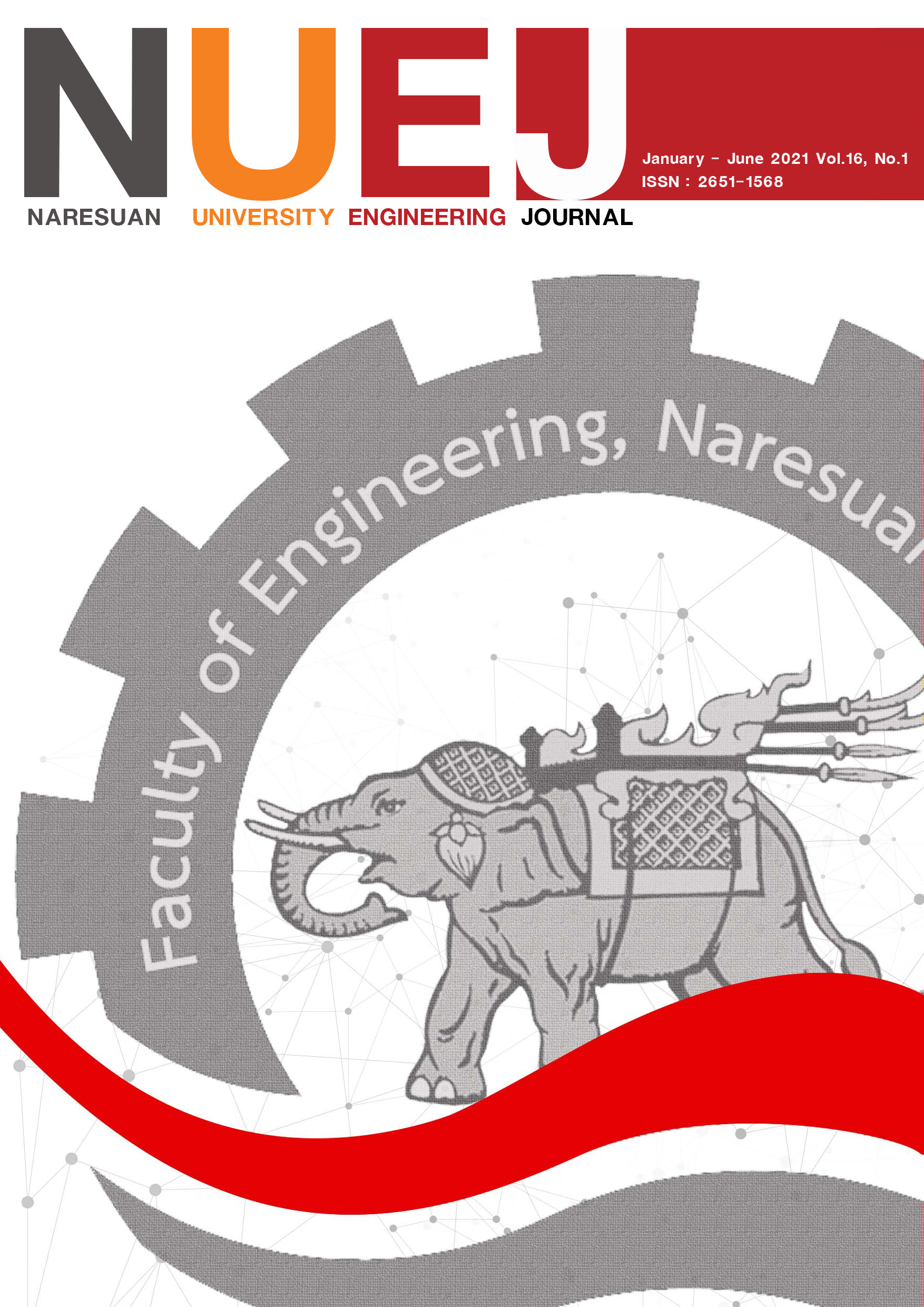การจำแนกสัญญาณไฟฟ้ากล้ามเนื้อตามเวลาจริงเพื่อควบคุมมือหุ่นยนต์
Main Article Content
บทคัดย่อ
บทความนี้นำเสนอระบบการบันทึกสัญญาณไฟฟ้ากล้ามเนื้อเพื่อนำข้อมูลไปใช้ในการสร้างต้นแบบของการจดจำรูปแบบสัญญาณไฟฟ้ากล้ามเนื้อเพื่อจำแนกท่าทางมือ โดยใช้ข้อมูลถุงมือ 5DT เพื่อตรวจจับข้อมูลท่าทางมือและปลอกแขน MYO เพื่อรับสัญญาณไฟฟ้ากล้ามเนื้อ อุปกรณ์ที่เพิ่มเติมเข้ามาเพื่อช่วยในการอ้างอิงกลุ่มของข้อมูลเพื่อทำให้ระบบมีความรวดเร็ว แม่นยำ และมีความสะดวกสบายในการใช้งาน ระบบนี้สามารถจำแนกสัญญาณไฟฟ้ากล้ามเนื้อจาก 3 ท่าทางมือประกอบด้วย ท่ากำมือ ท่าแบมือ และท่าพักมือ นอกจากนี้ระบบยังคำนึงถึงผลกระทบของการเคลื่อนที่แขนต่อสัญญาณไฟฟ้ากล้ามเนื้อ โดยใช้ตัวจำแนกสัญญาณคือ Support Vector Machine (SVM), Linear Discriminant Analysis (LDA) และ Artificial Neural Network (ANN) ระบบพัฒนาขึ้นเมื่อทำการเก็บข้อมูลที่ไม่ใช้อุปกรณ์เพิ่มเติมจะให้ประสิทธิภาพในการจำแนกสัญญาณไฟฟ้ากล้ามเนื้ออยู่ที่ 95.95% ส่วนเบี่ยงเบนมาตรฐานที่ ±1.13% ด้วยตัวจำแนกสัญญาณแบบ ANN และในกรณีใช้ถุงมือข้อมูลช่วยในการเก็บข้อมูลจะให้ประสิทธิภาพในการจำแนกสัญญาณไฟฟ้ากล้ามเนื้ออยู่ที่ 97.37% ส่วนเบี่ยงเบนมาตรฐานที่ ±2.83% การบันทึกข้อมูลแบบใช้กรณีใช้ถุงมือข้อมูลช่วยในการเก็บข้อมูลใช้เวลาการบันทึกประมาณ 5 นาทีต่อหนึ่งอาสาสมัครและการบันทึกข้อมูลแบบไม่ใช้อุปกรณ์จะใช้เวลาประมาณ 12 นาทีต่อหนึ่งอาสาสมัคร ซึ่งเห็นได้ว่าระบบที่นำเสนอช่วยให้การบันทึกสัญญาณไฟฟ้ากล้ามเนื้อมีความรวดเร็วมากขึ้นถึง 2.4 เท่า
Article Details
เอกสารอ้างอิง
Agamemnon, K., Iris, K., Mustafa, E., Kianoush, N., &Sethu, V. (2019). Improved prosthetic hand control with concurrent use of myoelectric and inertial measurements. Journal of NeuroEngineering and Rehabilitation, 14, 71.
Al-Ani, A., & Deriche, M.. (2002). Feature selection using a mutual information based measure. In Object recognition supported by user interaction for service robots, 4, 82–85.
Al-Timemy, A. H., Khushaba, R. N., Bugmann, G., & Escudero, J. (2016). Improving the Performance Against Force Variation of EMG Controlled Multifunctional Upper-Limb Prostheses for Transradial Amputees. IEEE Transactions on Neural Systems and Rehabilitation Engineering, 24(6), 650–661.
Barrios, L. A. (2010). Real-time control of a multi-fingered robot hand using EMG signals [Master’s thesis]. San Diego State University. https://digitallibrary.sdsu.edu/islandora/object/sdsu%3A4720
Capa, E., Cotur, Y., Gumus, C., Kaplanoglu, E., & Ozkan, M. (2014). Comparative EMG classification of index finger (pp. 1-3). Istanbul, Turkey. https://doi.org/ 10.1109/BIYOMUT.2014.7026365
Castellini, C., Artemiadis, P., Wininger, M., Ajoudani, A., Alimusaj, M., Bicchi, A., Caputo, B., Craelius, W., Dosen, S., Englehart, K., Farina, D., Gijsberts, A., Godfrey, S. B., Hargrove, L., Ison, M., Kuiken, T., Marković, M., Pilarski, P. M., Rupp, R., & Scheme, E. (2004). Proceedings of the first workshop on Peripheral Machine Interfaces: going beyond traditional surface electromyography. Frontiers in Neurorobotics, 8, 22.
Cortes, C., & Vapnik, V. (1995). Support-vector networks. Machine Learning, 20(3), 273–297.
Data Gloves 5DT. (2018). 5DT. http://www.5dt.com/data-glovesde Sá, J. P. M. (2012). Pattern Recognition: Concepts, Methods and Applications. Springer Science & Business Media.
Fougner, A., Scheme, E., Chan, A. D. C., Englehart, K.,,& Stavdahl, Ø. (2011). Resolving the Limb Positione Effect in Myoelectric Pattern Recognition. IEEE Transactions on Neural Systems and Rehabilitation Engineering, 19(6),644–651.
Gauthaam, M., & Kumar, S. (2011, February). EMG controlled bionic arm [Paper presentation]. 2011 National Conference on Innovations in Emerging Technology, Erode, India
Gu, Y., Yang, D., Huang, Q., Yang W., & Liu, H. (2018). Robust EMG pattern recognition in the presence of confounding factors: Features classifiers and adaptive learning. Expert Systems with Applications, 96, 208-217.
Hakonen, M., Piitulainen, H. ., & Visala, A. (2015). Current state of digital signal processing in myoelectric interfaces and related applications. Biomedical Signal Processing & Control, 18, 334–359.
Jiang, N., Dosen, S., Muller, K., & Farina, D. (2012). Myoelectric Control of Artificial Limbs amp-Is There a Need to Change Focus?. IEEE Signal Processing Magazine, 29(5), 152–150.
Jianwei, L., Dinggua, Z., Xinjun, S.,& Xianyang, Z. (2014). Quantification and solutions of arm movements effect on sEMG pattern recognition. Biomedical Signal Processing and control. Science Direct, 13, 189-197.
Karen, T., Michael, C., Eduardo, R. & Diego, F. (2018). Stepping-stones to Transhumanism: An EMG-controlled Low-cost Prosthetic Hand for Academia (pp. 807-812). Funchal, Portugal.https://doi.org/10.1109/IS.2018.8710489
Keinosuke, F. (1990). Introduction to Statistical Pattern Recognition (2nd ed.). Academic Press.
Konig, A. (2000). Dimensionality reduction techniques for multivariate data classification, interactive visualization, and analysis-systematic feature se lection vs. extraction. Fourth International Conference on Knowledge-Based Intelligent Engineering Systems and Allied Technologies. Proceedings, 1, 44–55.
Konig, A., Eberhard, M., & Wenzel, R. (1998). A transparent and flexible development environment for rapid design of cognitive systems. 24th EUROMICRO Conference, 2, 655–662.
Myo Gesture Control Armband. (2018). MYO Alpha . https://www.myo.com
Nguyen, N. T. N. (2018). Developing A low-cost Myoelectric Prosthetic hand. Metropolia University of Applied Sciences.
Oskoei, M. A.,& Hu, H. (2007). Myoelectric control systems-A survey. Biomedical Signal Processing and Control, 2, 275–294.
Pan, L., Li, J., Xia, W., Zhang, D., & Dong, L. (2015). An effective method, composed of LAMP and dCAPS, to detect different mutations in fenoxaprop-P-ethyl-resistant American sloughgrass (Beckmannia syzigachne Steud.) populations. Pesticide Biochemistry and Physiology, 117, 1–8.
Phinyomark, A., Phukpattaranont, P., & Limsakul, C. (2012). Feature reduction and selection for EMG signal classification. Expert Systems with Applications, 39(8), 7420–7431.
Raez, M. B. I., Hussain, M. S., & F. Mohd-Yasin. (2006). Techniques of EMG signal analysis: detection. Biological Procedures Online, 8, 11–35.
Roberto, A., Jose, M.S.,& Rosa, M.V. (2010). Edited Nearest Neighbor Rule for Improving Neural Networks Classifications. Advance in neural networks, 6063, 303-310.
Stango, A., Negro, F., & Farina, D. (2015). Spatial Correlation of High Density EMG Signals Provides Features Robust to Electrode Number and Shift in Pattern Recognition for Myocontrol. IEEE Transactions on Neural Systems and Rehabilitation Engineering, 23(2), 189–198.
Steven, W. S. (2003). The Scientist and Engineer’s Guide to Digital Signal Processing’s Table of Content. California Technical Publishing.
Tipping, M. E., & Bishop, C. M. (1999). Mixtures of Probabilistic Principal Component Analysers. Neural computation, 11(2), 443-482.
Wright, T. W., Hagen, A. D.,& Wood, M. B. (1995). Prosthetic usage in major upper extremity amputations. Journal of Hand Surgery, 20(4), 619–622.
Young, A. J., Hargrove, L. J.,& Kuiken, T. A. (2012). Improving Myoelectric Pattern Recognition Robustness to Electrode Shift by Changing Interelectrode Distance and Electrode Configuration. IEEE Transactions on Biomedical Engineering, 59(3), 645–652.
Zhang, D., Xiong, A., Zhao, X., & Han, J. (2012). PCA and LDA for EMG-based control of bionic mechanical hand (pp. 960-965). Shenyang, China. https://doi.org/10.1109/ICInfA.2012.6246955


